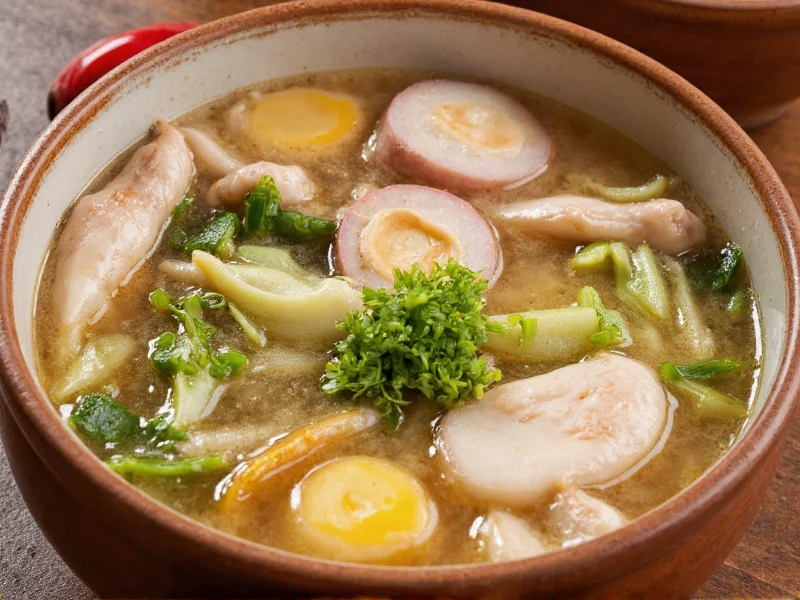Miso soup represents one of Japan's most fundamental culinary staples, served daily in households and restaurants across the country. This seemingly simple broth carries centuries of culinary tradition and offers remarkable versatility while maintaining its essential character. Understanding the authentic components of miso soup helps both home cooks and food enthusiasts appreciate this cultural treasure beyond its basic preparation.
Core Components of Authentic Miso Soup
At its foundation, miso soup requires three essential elements that create its distinctive flavor profile and nutritional benefits. These components work in harmony to produce the comforting umami-rich broth familiar to millions worldwide.
Dashi: The Flavor Foundation
Dashi serves as the critical base for authentic miso soup, providing the subtle umami backbone that defines Japanese cuisine. Traditional dashi preparation involves simmering:
- Kombu (dried kelp) - for deep oceanic notes
- Katsuobushi (dried bonito flakes) - for savory complexity
Vegetarian variations might use only kombu or incorporate dried shiitake mushrooms. The quality of dashi directly impacts the final soup, making it arguably more important than the miso paste itself in traditional preparation.
Miso Paste: The Heart of the Soup
Miso paste transforms simple dashi into the distinctive soup recognized globally. This fermented product comes in several varieties that significantly affect the soup's character:
| Miso Type | Color | Flavor Profile | Regional Origin | Best For |
|---|---|---|---|---|
| Shiro Miso | White/light yellow | Sweet, mild | Kansai region | Delicate soups, summer dishes |
| Aka Miso | Red/brown | Salty, robust | Kanto region | Hearty winter soups |
| Mugi Miso | Tan | Earthy, complex | Nagano prefecture | Traditional country cooking |
| Hatcho Miso | Dark brown | Intense, rich | Aichi prefecture | Specialty preparations |
The fermentation process for miso typically ranges from several weeks to multiple years, developing complex flavors through the action of koji mold (Aspergillus oryzae) on soybeans, grains, and salt.
Traditional Additions to Miso Soup
While the dashi-miso combination forms the essential base, certain additions have become standard in most traditional preparations:
Tofu: The Protein Element
Silken or soft tofu cut into small cubes represents the most common addition to miso soup. The delicate texture contrasts beautifully with the rich broth while providing complete plant-based protein. Firm tofu appears less frequently in traditional preparations as it doesn't absorb flavors as readily.
Wakame: The Sea Vegetable
Dried wakame seaweed rehydrates quickly in the hot broth, adding both visual appeal and nutritional value. This oceanic component provides essential minerals and creates the characteristic green flecks throughout the soup. Some regional variations substitute hijiki or other seaweeds based on local availability.
Regional Variations Across Japan
Japan's diverse culinary landscape produces notable regional differences in miso soup preparation:
- Kanto region (Tokyo area): Features darker, saltier aka miso with robust flavors
- Kansai region (Osaka/Kyoto): Prefers milder shiro miso with sweeter profile
- Tohoku region: Often includes hearty additions like root vegetables
- Kyushu region: May incorporate local seafood elements
Modern Adaptations and Common Misconceptions
Contemporary interpretations of miso soup sometimes deviate from traditional preparations. While innovation has its place, understanding authentic components helps distinguish genuine miso soup from imitations.
What's Not Traditionally Included
Despite common misconceptions in Western adaptations, traditional miso soup typically does NOT contain:
- Ramen noodles (this creates a different dish entirely)
- Meat broth instead of dashi (compromises vegetarian authenticity)
- Excessive amounts of miso paste (proper ratio is crucial)
- Pre-made broth cubes (traditional preparation requires fresh dashi)
Vegetarian and Vegan Considerations
Authentic miso soup can be vegetarian or vegan when prepared with kombu-only dashi. Many Western versions unknowingly contain katsuobushi (fish-based), making them unsuitable for strict vegetarians. Those seeking plant-based miso soup should specifically request kombu dashi preparation.
Nutritional Profile of Traditional Miso Soup
Beyond its culinary significance, miso soup offers notable nutritional benefits when prepared traditionally. A standard serving (about 1 cup) typically contains:
- Approximately 40-60 calories
- 2-4 grams of plant-based protein
- Significant probiotics from fermented miso
- Essential minerals from seaweed components
- Vitamins B and K from fermentation process
The fermentation process enhances digestibility and increases bioavailability of nutrients, making miso soup particularly valuable for gut health.
Proper Preparation Techniques
The method of preparation significantly affects the final product's quality. Key techniques include:
- Never boiling miso paste (dissolve in ladle with hot dashi first)
- Maintaining proper temperature (160-170°F / 70-75°C) to preserve probiotics
- Using appropriate miso-to-dashi ratio (typically 1-2 tablespoons per cup)
- Adding delicate ingredients like tofu and wakame at the end
These techniques preserve the enzymatic activity and delicate flavors that define high-quality miso soup.
Cultural Significance in Japanese Cuisine
Miso soup represents more than just a culinary element in Japan—it embodies cultural values and daily rhythms. Served at nearly every traditional meal, it symbolizes hospitality and nourishment. The Japanese saying "ichiju-sansai" (one soup, three sides) highlights how miso soup forms an essential component of balanced eating in Japanese culture.











 浙公网安备
33010002000092号
浙公网安备
33010002000092号 浙B2-20120091-4
浙B2-20120091-4